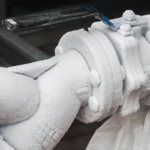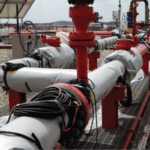In Mid-February 2021, a winter ice storm pounded Texas and lasted for four days as it knocked out power and froze pipes all the way to Canada. Not your typical winter state, Texas experienced about half of the country’s $18 billion in insurance claims, primarily due to frozen pipes.
People think freeze protection for pipes is a residential problem, but every business and industry is susceptible. Anytime a pipe lays against uninsulated walls or is exposed to cold weather, the water can freeze inside the lines and burst. A frozen pipe bursting can cause thousands of dollars of property damage and a massive water bill overnight. Even if the pipe doesn’t break, such as an oil pipeline, the blocked pipe will shut down production until it has thawed.
Industries using water supply pipes as part of their process or have uninsulated fire protection systems must take steps to prevent pipes freezing.
Provided that the utilities stay on, we’ll show you the most efficient method of how to keep pipes from freezing for your business.
What is Pipe Freeze Protection?
Pipe freeze protection means insulating pipes from cold air and adding heat to them to maintain temperatures above freezing. Some heating systems use radiant heat or hot water to keep the pipes warm. Unfortunately, they are not practical for most industrial uses.
Freshwater freezes at 32°F (0°C), and seawater freezes at 28°F (-2.2°C). If the water flows inside the pipe, it takes a lower ambient temperature to freeze it, approximately 14°F (-10°C). Unless your business is in an area where the ambient temperature never drops below the freezing point, you need pumps and pipe freeze protection.
4 Types of Freeze Protection for Pipes
Unless the pipe is inside a heated building, preventing frozen pipes requires direct heat and thermal insulation.
1. Electric Heat Tape
Heat tape is a solution for plastic pipes and other small pipes. Also known as a heat trace, it consists of electrical heating wires inside a protective coating such as plastic or silicone. It will be 1/2 to 1 inch wide, and the tape wraps around the pipe and valves, supplying heat and preventing frozen pipes.
It’s a good solution for short runs of 15 to 30 feet and pipes up to 3” in diameter, not exposed to the weather. It’s mostly for residential use.
2. Heating Cables
Heating cables are heavier than heat tape. These heavy-duty cables wrap around pipes and valves to provide constant direct heat. The drawback is that it leaves much of the pipe area exposed, so some of the pipes can still freeze in icy weather. For most applications, heating cables require an insulation wrap to provide better coverage and prevent heat loss.
Depending on the pipe and the ambient temperatures, two cables may be necessary to prevent pipes from freezing, adding material and labor costs.
3. Insulation Wrap
Wrapping pipes and valves with thermal insulation over the heating cables is an excellent combination to keep pipes from freezing in cold weather. Insulation alone is not enough to prevent freezing pipes. The cold will eventually penetrate and freeze the pipe without an additional heat source.
4. Heating Blankets
The best heating system to prevent pipes from freezing is a heating blanket. It combines heating elements embedded in an insulating, weatherproof blanket. Powerblanket heating blankets fit any size pipe, valve, or tank. It is an economical solution for pipe freeze protection because they are portable, easy to install, and constructed with weatherproof materials that will last for years.
Protecting Pipes in Freezing Weather
One energy service provider lost thousands of dollars per day when their wellhead transmitters froze. Powerblanket custom-designed heaters to supply heat to the pipeline, valves, and transmitters to keep the operation flowing during the coldest winter months.
Water pipes or pipes that contain high viscosity fluids need additional heat to maintain a steady flow rate. Using Powerblanket heating blankets saves time and labor costs. Unlike heat trace cables, they install faster and provide warmth and insulation to the entire pipe and valve surfaces.
The advantages of heating blankets compared to heat trace cables include:
- Easy to install and remove
- Built-in safety measures to prevent overheating
- Fully insulated to maximize heat efficiency
- Custom designs for valves, manifolds, and other equipment
- Patented heat spreading material for even heat distribution
- No electrical current inrush issues
- Suitable for hazardous areas
Powerblanket has the expertise to eliminate cold weather costs by providing freeze protection for pipes in any industry.
Custom Solutions for Protecting Pipes in Freezing Weather
Powerblanket has a full line of ready-to-ship standard-sized pipe heaters. They cover pipes from 4 in. (10 cm) up to 12 in. (30 cm) in diameter and lengths up to 20 ft. (6.1 m). The blanket can provide maximum heat of 90°F (± 10°F) / 32°C (± 5°C). Most blankets require only 120v power between 320 watts to 1,800 watts. Depending on the size, the blankets need a 15 to 30 amp plug.
If you require a custom solution due to the configuration of the pipe run, our engineers can design custom pipe heaters to fit any process. Typically, we can ship custom heating blankets within two weeks.
Powerblanket pipe heaters offer weatherproof freeze protection for PVC, cast iron, and steel pipes. The efficient design eliminates the labor expense of work crews to install or remove heat trace, thermal insulation, and cladding because they attach securely with nylon straps.
Efficient pipe freeze protection reduces downtime and increases profitability. It also eliminates the need for alternative emergency services or steamers. Protect sensitive instruments and valves with Powerblanket heating solutions.
Frequently Asked Questions
What is the best thing to stop pipes from freezing?
The best way to stop pipes from freezing is to use a combination of insulation and heating solutions, such as heating blankets, which provide consistent warmth and protection against cold temperatures.
At what temperature will inside pipes freeze?
Inside pipes are at risk of freezing when temperatures drop below 32°F, but they are more likely to freeze when temperatures fall below 20°F if not properly insulated and heated.
Will my pipes freeze if my heat is on 60?
Keeping your home’s heat set to around 60 degrees Fahrenheit can help prevent pipes from freezing, as it maintains a warm enough environment to protect them from cold temperatures.
Pipe heaters from Powerblanket keep your fluids flowing all year long, providing freeze protection for your entire system.




